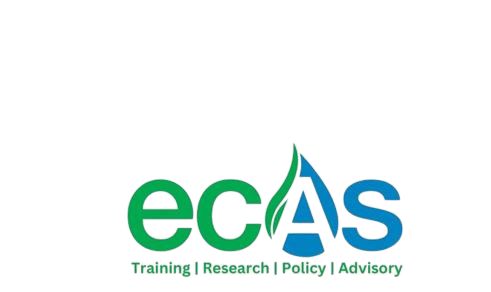
INTERNATIONAL TRAINING ON DATA VISUALIZATION FOR ENVIRONMENTAL COMMUNICATION
COURSE BACKGROUND
In today’s data-rich world, environmental professionals are increasingly faced with the challenge of communicating complex scientific and statistical information to diverse audiences – from policymakers and stakeholders to the general public. Raw data, complex models, or dense reports often fail to convey critical insights effectively, leading to misunderstandings, disengagement, or inaction. Data visualization, when done effectively, transforms abstract numbers and trends into compelling, understandable, and actionable visual narratives. It is an indispensable skill for anyone aiming to influence environmental decision-making and foster greater awareness.
ECAS Institute offers this “Data Visualization for Environmental Communication” course to bridge the gap between environmental data analysis and impactful communication. This program will equip participants with the principles of effective visual design, the tools to create various types of environmental visualizations, and the strategic understanding of how to tailor these visuals for different communication objectives and audiences. Through hands-on exercises and real-world environmental case studies, participants will learn to craft compelling visual stories that resonate, educate, and drive action for environmental sustainability.
COURSE OBJECTIVES OF THE TRAINING
Upon successful completion of this course, participants will be able to:
- Understand the fundamental principles of effective data visualization and their application to environmental topics.
- Select the appropriate visualization type for different environmental datasets and communication goals.
- Design clear, accurate, and compelling charts, graphs, and maps that avoid misrepresentation.
- Utilize visualization tools (e.g., Tableau, Power BI, Python/R libraries) to create interactive and static environmental visuals.
- Develop visual narratives that effectively communicate complex environmental information to diverse audiences.
- Critically evaluate existing environmental data visualizations for effectiveness and potential biases.
- Apply best practices in color theory, typography, and layout for impactful environmental communication.
WHAT YOU WILL LEARN
This course will enable you to transform complex environmental data into clear, compelling, and actionable visual stories for various audiences. You will learn to:
- Understand the science and art behind effective data visualization, particularly for environmental themes.
- Identify the strengths and weaknesses of different chart types (e.g., bar, line, scatter, heat maps) for specific environmental data.
- Master techniques for visualizing spatial data using maps and combining them with other data types.
- Apply principles of visual perception and cognitive load to design intuitive and easy-to-understand graphics.
- Use professional visualization software or programming libraries to create both static and interactive dashboards and reports.
- Develop a storytelling approach using data visuals to highlight environmental issues, trends, and solutions.
- Ensure ethical and accurate representation of environmental data, avoiding misleading visuals.
- Tailor your visualizations for different communication channels and stakeholder groups (e.g., scientific reports, public presentations, social media).
DURATION AND PROGRAM
This is a structured training course designed to provide comprehensive insights and practical skills in data visualization for environmental communication. The program will combine theoretical principles of visual communication with extensive hands-on exercises using relevant software tools, and analysis of real-world environmental case studies. The detailed program schedule, including specific session timings and learning activities, will be communicated upon registration.
TARGET PARTICIPANTS
This course is ideal for environmental professionals, scientists, communicators, and analysts who need to effectively convey environmental data and insights to various audiences. It is particularly beneficial for:
- Environmental scientists and researchers
- Sustainability and ESG professionals
- Environmental policy analysts and advocates
- Data analysts working in environmental organizations
- Environmental educators and communicators
- GIS specialists seeking to enhance their visualization skills
- NGO staff involved in public awareness campaigns
- Government officials responsible for environmental reporting
- Anyone needing to present environmental data clearly and persuasively.
TRAINING MODULES
The course is structured to guide participants through the process of creating impactful environmental visualizations, from foundational principles to advanced techniques and ethical considerations:
| No | Module | Details | |
| 1. | Foundations of Environmental Data Visualization |
This module introduces the core concepts and importance of visual communication in environmental contexts.
Key Topics:
|
|
| 2. | Chart Types for Environmental Data |
This module explores various standard chart types and when to use them effectively for different environmental datasets.
Key Topics:
|
|
| 3. | Mapping Environmental Data (Geospatial Visualization) |
This module focuses on visualizing spatial environmental information using maps, a critical component for many environmental topics.
Key Topics:
|
|
| 4. | Principles of Visual Design and Aesthetics |
This module delves into the aesthetic and design considerations that make visualizations impactful and easy to understand.
Key Topics:
|
|
|
5.
|
Crafting Environmental Data Narratives |
This module focuses on transforming static visuals into compelling stories that engage and persuade audiences.
Key Topics:
|
|
| 6. | Tools for Environmental Data Visualization |
This module provides hands-on experience with popular software and programming libraries used for data visualization.
Key Topics:
|
|
| 7. | Ethical Considerations and Avoiding Misleading Visuals |
This module addresses the critical responsibility of visualizers to present environmental data accurately and ethically.
Key Topics:
|
|
| 8. | Case Studies and Practical Application |
This module applies all learned concepts through analysis of diverse environmental visualization case studies and a final project.
Key Topics:
|
|
TRAINING STYLE
The modules will be taught through PowerPoint presentations, and lectures and will include a case study/field visit, breakout sessions, case studies and other interactive discussion components.
The course will also include a few guest speakers, both in person and via Zoom and other online learning platforms for overseas speakers. This provides useful real-world insights alongside the more theoretical aspects of the course.
The conference faculty shall consist of experienced decision makers, as well as practitioners and representatives from established educational and research institutions active around climate change, engineering and international development. Throughout the course, theoretical presentation of concepts will be moderated and more group discussions and plenary engagements will be optimized. PowerPoint presentations will be made by facilitators and resource persons, to highlight key concepts before embarking on group work.
GENERAL NOTES
- Training manuals and additional reference materials are provided to the participants.
- Upon successful completion of this course, participants will be issued with a certificate.
- We can also do this as a tailor-made course to meet organization-wide needs. Contact us to find out more: info@ecasiafrica.org.
- Payment should be sent to our bank account before the start of training and proof of payment sent to: info@ecasiafrica.org.
ABOUT ECAS INSTITUTE
The ECAS Institute designs and delivers independent and targeted training, research, and consulting services. Our work focusses on climate change and resilience building, carbon markets, renewable energy, nature-based solution, biodiversity conservation, agriculture and food systems, We are located in Nairobi Kenya and work across the African region. We have implemented training and research assignments in Kenya, Tanzania, Uganda, South Sudan, Somalia, Malawi, Rwanda, Congo, and South Africa. Globally, we have supported our partners from the UK, Denmark, Italy, Sweden, Germany, and USA.
